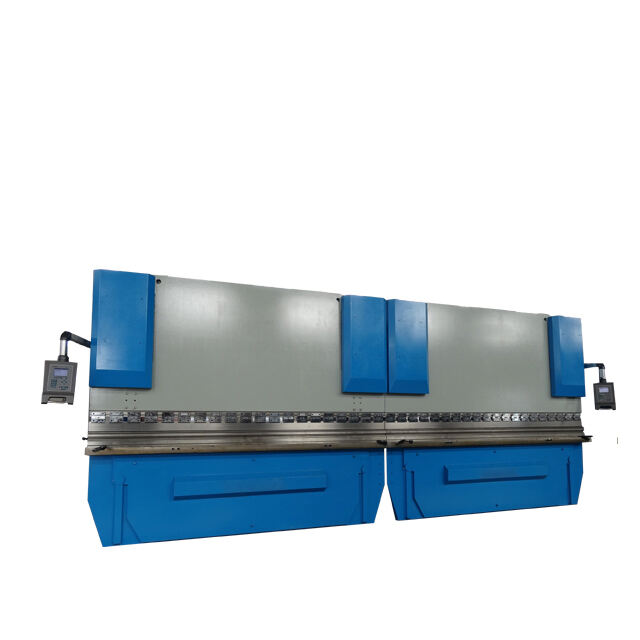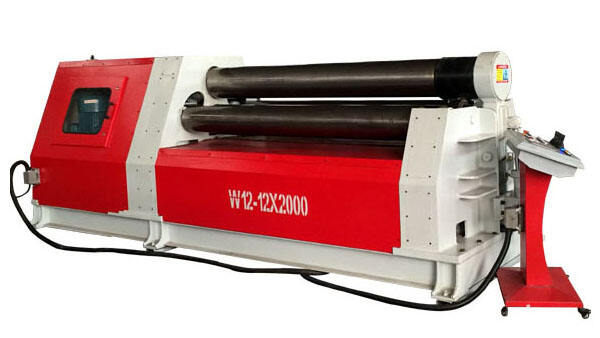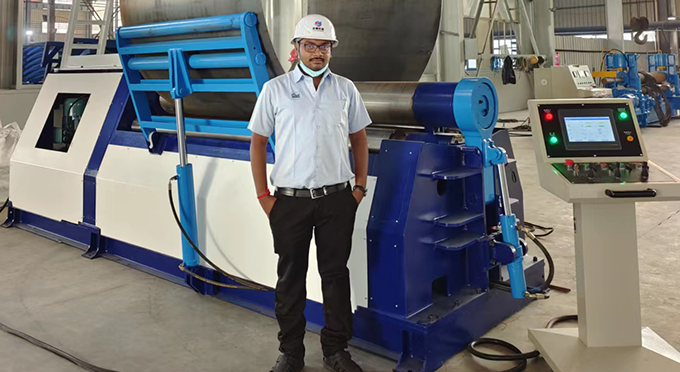Understanding Press Brake Types and Their Industrial Applications
Hydraulic press brakes: Power and reliability for heavy-duty fabrication
In industrial fabrication shops across the country, hydraulic press brakes stand out as essential tools when working with tough materials that need serious force applied consistently. These machines rely on synchronized hydraulic cylinders to generate massive pressure, often reaching well beyond 6,000 tons. That kind of power makes them perfect for shaping things like armor plating, heavy structural steel beams, and specialized parts needed for aircraft construction or deep sea vessels. What really sets them apart is their oil-based system which gives operators fine control over how fast the ram moves and exactly how deep it goes into the material being formed. This level of precision matters a lot in factories where every bend needs to match specifications down to the millimeter. A recent look at industry trends from 2023 shows just how dominant these hydraulic systems remain: they handle around 92 percent of all bends made on steel thicker than 10mm in both shipyards and mines where durability is absolutely critical.
CNC press brakes: High-precision automation for complex bending tasks
Modern CNC press brakes can achieve repeatability within about 0.01 mm thanks to their servo electric axis controls. This level of precision makes them ideal for creating complex components like those needed for heat exchangers or elevator panels. The machines come with built in programmable crowning systems that adjust automatically when there's frame deflection during work on tough materials above 650 MPa tensile strength. According to recent studies from Metalforming Journal in 2023, this feature cuts down springback errors by roughly 34% compared to what happens with manual setup methods. Plus these advanced systems store thousands of different programs, sometimes upwards of 5,000, and switch between profiles in less than ninety seconds flat. No wonder so many companies manufacturing medical imaging equipment and semiconductor tools have started relying heavily on this technology instead of older alternatives.
Mechanical and electric hybrid models: Balancing speed, efficiency, and control
Hybrid press brakes combine mechanical flywheel energy storage with electric servo controls, cutting down on energy use by around 58% according to Mac-Tech's 2023 findings. These machines still manage to handle up to 25 bends every minute though. The dual drive setup works really well in car manufacturing plants, especially when switching back and forth between those super thin aluminum trim pieces at just 1.5 mm thick and much heavier suspension parts that measure about 8 mm. What makes this technology stand out is how it handles different materials. The mechanical part gives the punch needed for strong bends, whereas the electric servos take care of adjusting angles precisely as they work through multiple steps. This combination improves not only what gets done but also how accurately it happens.
Comparing performance across press brake types using key operational metrics
| Metric | Hydraulic | CNC | Hybrid |
|---|---|---|---|
| Max Tonnage | 6,000+ Tons | 1,200 Tons | 2,500 Tons |
| Positioning Accuracy | ±0.1mm | ±0.01mm | ±0.05mm |
| Energy Efficiency | 65-78% | 92-95% | 82-88% |
| Ideal Material Range | 3-150mm Steel | 0.5-25mm Alloys | 1-40mm Composites |
This comparison helps fabricators select the right machine based on priorities€”whether it€™s raw power for bridge girders or micron-level precision for aerospace fasteners.
Matching Press Brake Capacity to Material Requirements
Selecting the appropriate press brake based on material properties ensures optimal performance, minimizes wear, and maintains bend consistency.
How Material Type and Thickness Influence Press Brake Selection
How different materials react when stressed makes a big difference in what equipment works best. Take mild steel versus stainless steel for instance – mild needs around 20 to 25 percent less pressure to achieve the same bend because it just isn't as strong. Aluminum is another story entirely though. Its ability to stretch more means we need special techniques to account for how it springs back after bending. When dealing with thicker sheets six millimeters or more, most shops go with hydraulic presses or hybrid machines rated for at least 150 tons to get consistent bends every time. But thinner stuff below three millimeters tells a different tale. These require something else altogether, like CNC controlled systems or electric brakes that can adjust pressure really precisely. This matters a lot in facilities where they switch between many different materials throughout the day. The fine control these machines provide ensures parts come out exactly right batch after batch, which is why so many manufacturers are making the switch nowadays.
Calculating Maximum Bend Thickness Using Tonnage, Die Width, and Material Strength
There's a standard formula to figure out the minimum tonnage needed for bending operations: Tonnage equals Material Tensile Strength multiplied by Thickness squared times Bend Length, all divided by eight times Die Width. Let's say we need to bend 4 feet of 10-gauge stainless steel that's about 0.101 inches thick with a tensile strength around 60 ksi. If we're using a 1 inch wide die, our calculations show we'd need roughly 132 tons of force. But here's something important to remember: when running machinery at more than 85% of its maximum rating, there's a real chance of deflection problems. This can lead to those annoying angular errors where the bend ends up off by more than 0.0015 inches per foot length. That kind of deviation adds up fast in production environments.
Accounting for Springback and Tensile Properties in Bend Accuracy
Springback varies by material: cold-rolled steel typically rebounds 2-5°, aluminum 8-12°, and high-strength alloys up to 15°. Modern CNC systems counteract this by calculating overbend angles using real-time tensile data. A target 90° bend in 6061-T6 aluminum, for instance, often begins with a 93° tool angle to achieve final dimensional accuracy after elastic recovery.
Optimizing Bending Precision Through Tooling and Machine Capabilities
Standard vs. specialized tooling for diverse bend profiles and production needs
The standard stuff we typically see around shops these days handles most everyday bending jobs, probably somewhere between 80 to 90 percent of what gets done regularly. But when things get complicated with unusual shapes or tricky bends, regular tools just don't cut it anymore. For those really tight corners under 1.5mm radius or working with tough materials such as aerospace aluminum and hardened steels, specialized equipment becomes necessary. Shops dealing with mixed production runs find multi-radius dies particularly helpful since they cut down on how often operators need to switch out tools. And let's not forget about those acute angle punches at 30 degrees or less which make those razor sharp folds possible without wrecking the material itself according to MachineTool Insights from last year.
Strategies for reducing setup time and extending tool life
Getting alignment right can slash setup times by as much as 40% when dealing with production runs that have lots of variation. Some real game changers here are things like laser calibration for those die stations, which hits around plus or minus 0.01 mm tolerance. Then there's the modular quick change tooling systems that shave off about 5 to 8 minutes during machine changes. And don't forget about those titanium nitride coatings either they really make a difference, extending die life almost three times longer in tough jobs such as working with stainless steel. Oh, and integrated CNC lubrication systems help prevent galling problems while keeping material waste under control at just over 3%. These numbers come from the latest FMG Fabrication Efficiency Report released back in 2023.
Achieving accurate bend angles and radii with CNC controls and stroke precision
Modern CNC press brakes come equipped with real time force feedback that helps compensate for springback issues. This feature becomes really important when working with materials that have high elasticity such as spring steel, which tends to bounce back anywhere between 14 to 18 degrees after bending. The system works best when combined with precisely ground tools and backgauge systems that offer resolution down to just 0.001 mm. These setups generally keep angles consistent within plus or minus 0.25 degrees across multiple parts. For even greater accuracy, closed loop hydraulic controls deliver repeatable strokes at 0.005 mm tolerance. According to recent data from BendingTech Quarterly in 2024, this level of precision leads to getting the first part right on target about 92 times out of 100 during actual production runs.
Evaluating Workflow Integration: Bed Length, Tonnage, and Shop Floor Layout
Integrating press brakes effectively into a fabrication workflow requires alignment with spatial constraints and upstream/downstream processes. Bed length determines maximum part size; a 10-foot brake accommodates approximately 80% of standard commercial sheet metal components (Fabricators & Manufacturers Association 2023). Undersized beds lead to inefficient multi-stage bending, increasing labor and error risks.
Three key factors guide layout optimization:
- Bed length: Match to largest expected part dimensions with a 15% safety margin
- Tonnage: Calculate based on material yield strength and recommended V-die width ratios
- Workflow patterns: U-shaped cell layouts reduce material handling distance by 22% versus linear arrangements (MHI 2023)
Manufacturers who combine digital simulations with actual prototypes have seen their press brake relocation expenses drop by around 34% according to a study from last year at several factories. Top performing plants tend to place their press brakes no more than twenty feet away from both laser cutting machines and deburring workstations. This arrangement creates efficient workflow routes that were actually tested with motion tracking technology as reported by Deloitte in 2024. The whole point is to cut down on unnecessary movements across the shop floor without compromising safety requirements when workers need to load materials, unload finished parts, or switch out tools during production runs.
Frequently Asked Questions
What is the main advantage of hydraulic press brakes?
The main advantage of hydraulic press brakes is their ability to exert massive force, essential for shaping armor plating, structural steel, and specialized parts for aerospace and marine applications.
How do CNC press brakes improve precision?
CNC press brakes use servo electric axis controls to achieve high precision, repeatability, and programmable crowning systems, reducing errors and enhancing the production of complex components.
Why are hybrid press brakes considered energy efficient?
Hybrid press brakes combine mechanical and electric servo controls, reducing energy consumption significantly while maintaining speed and performance, making them suitable for varied industrial applications.




